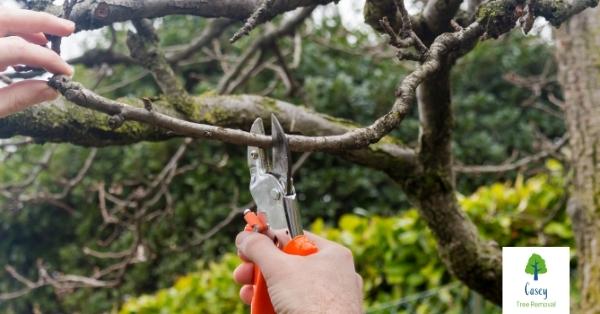Have you ever wondered the best time of the year to prune trees is?
We get asked this question a lot and the answer is …
It depends.
That’s why we create this winter pruning guide, to help people understand.
Not all trees are the same and there are many factors to consider when it comes to pruning such as age, size, species and even the season.
It can also depend on the purpose of trimming.
For instance, if pruning is required for safety reasons or because of dead or diseased branches, trimming can be performed any time.
Nevertheless, the overall health of the plant should always be taken into consideration before addressing pruning issues.
It is important to know that detrimental diseases can easily be spread if trees and shrubs are pruned at the wrong time of the year.
For example, oak trees (Quercus spp.) should only be pruned in the winter months when the trees are dormant to prevent the spread of a common fungal disease called oak wilt.
As a general rule, a light summer prune can be carried out on most deciduous shrubs and trees.
Heavier trimming should be performed once the tree is dormant, preferably in late winter prior to active growth begins.
Trees such as maple (Acer) bleed sap heavily and should be pruned in winter while the trees are dormant.
Pruning at any other time will reduce or eliminate the flower display.
Most conifers require minimal pruning that will also vary with species.
Needled evergreens such as spruce (Picea) and fir (Abies) are best pruned at the end of winter before growth starts.
Arborvitae (Thuja) and yew (Taxus) can be pruned during spring and early summer.
Trimming of any kind can encourage new growth; therefore, pruning should not be carried out late in the season to avoid the risk of cold temperatures damaging tender new growth.
Winter Pruning Guide: Advantages to Winter Pruning
Winter can be an ideal time to prune most trees and shrubs because many species are dormant throughout winter.
Correct pruning is a landscape practice that can enhance the health, vigour and aesthetics of your shrubs and trees.
Below are some advantages to trimming in the winter:
- During the winter, the majority of woody plants are dormant and so are the many diseases and insects that can potentially invade open cuts.
- After leaves have fallen, it is much easier to see the plants overall form and structure. Damaged and diseased branches are more readily apparent when not obscured by foliage.
- Pruning in late summer or early fall can stimulate new growth that may not harden off before the cold weather. This is not a concern during the winter season.
- Winter trimming is good for your plants, leaving them with extra root and energy reserves to quickly heal wounds and support vigorous spring growth that will obscure the pruning cuts.
- Winter trimming is also good for you, giving you a reason to go outside on a mild winter day to enjoy your landscape.
Although winter and early spring is a great time for you to prune, if the tree or shrub is a spring flowering plant and the blooms are important to you, it may be best to wait and prune that plant shortly after it is done blooming.
Even though pruning spring blooming plants in the winter will never adversely affect the plant’s health, it can reduce those blooms.
There are many reasons to prune woody plants and it’s a good idea to understand why you are pruning before you start.
Before making the first cut, ask yourself, why am I removing this branch? Have a goal in mind and a vision for how you want the shrub or tree to look when you are done.
The most common reason that homeowners prune their plants is to reduce or maintain a plants size.
Other reasons to prune include removing dead, diseased, or damaged branches; increasing flowers or fruits; stimulating growth; and removing branches that may be interfering with or obstructing pedestrians, traffic, and buildings.
There are two basic techniques that are used when pruning most woody plants: thinning and heading back. Both of these techniques should be practiced together when the objective is to reduce or maintain the size of the plant.
With both of these techniques, using sharp, high-quality, and well-maintained pruning equipment will make the job easier and less likely to cause damage to your plants
Thinning:
Thinning is the removal of an entire branch back to the next branch or the main trunk.
This technique promotes better health and form by removing weak and diseased branches and increasing light penetration and air movement.
When making a thinning cut, do not cut so near the trunk or next branch that you cut into the area at the base of the branch that you are removing. This area is called the branch collar.
By cutting into or removing the branch collar, you will slow down the healing process and possibly increase the risk of infection.
If you did it properly, you will see a circle of healthy callus material swell around the cut in the spring.
Heading Back:
This is simply shortening the length of the branch back to a bud or the next side branch. A proper heading back cut should never leave a stub.
Stubs that are left from pruning usual rot and later invite insects and disease to move in and attack healthy material.
Make your pruning cut at a slight angle about a above the bud or side branch.
Thoughtful pruning of your trees and shrubs during the dormant winter season will allow you more time to enjoy the fruits and blooms of your labours during the pleasant weather of spring!
Winter Pruning Guide: Tree Inspection
As leaves fall from the trees each autumn, branches formerly shrouded in dense foliage of a canopy reveal themselves once again.
Although given the choice, many people I know would prefer to never have to deal with the ensuing mess; I relish this time as an opportunity to inspect each tree canopy.
One important observation I make is to note any branches that may need to be removed.
The dormant months offer the best opportunity for a visual once-over, and provide the best time to remove branches.
Limbs of trees are pruned for any one of the following reasons; they’re dead or diseased, they’re crossing or rubbing another limb, they’re growing inward or competing with another branch and one needs to go.
Another reason for limb removal may be to raise or open the canopy, either to provide more vertical clearance or allow lighter to reach the ground.
However, there is a right and wrong way to prune those limbs. When cut properly, trees quickly recover but the wrong cut can create a snowball effect of negative consequences.
Winter Pruning Guide: Best Time to Prune
The best time to remove tree branches and limbs is in late fall through late winter.
Disease pathogens are inactive and therefore not a serious risk to damaging your trees.
However, a fresh cut or wound during the warmer months can be an easy entry point for diseases and pests.
Be aware that there are some trees that ‘bleed’ excessively when cut.
This is sap oozing from the fresh wound. Although it looks serious and unsightly, it causes no harm.
Some trees that are especially prone to bleeding include beech, birch, elm, maple and yellowwood.
You may be inclined to dress fresh cuts or wounds with tree paint or wound dressing, sold and marketed as such. My suggestion is that it is rarely necessary and most of the time actually slows down the natural healing process.
Trees are amazing at adapting to adverse conditions so my advice is to make a clean cut and leave it alone.
Pruning tree limbs can be a great improvement to the look and health of your total landscape if you follow the guidelines mentioned above.
Taking shortcuts or pruning at the wrong time can lead to more problems later.
Removing Tree Limbs Correctly
I strongly suggest the Three Step Approach to cutting tree limbs!
Step One:
Make the first cut about one or two feet out from the tree trunk.
This cut starts on the underside of the limb and goes into it, but only about a third of the way. This is a very important step in the process.
Step two:
Make the second cut is outside of the first cut another foot or two.
Make this cut all the way through the branch. The branch is likely to break away as you saw your way through the limb.
Because you’ve already made the first cut on the underside and closer in, the bark will not continue to tear down into the tree trunk.
Without the first cut, as the branch breaks away from the weight of the limb, the attached and uncut bark goes with it, tearing it from the tree as well.
This creates a big potential problem, allowing a large open wound and entry point for pests and diseases.
Step Three:
The final cut is right at the branch collar where the branch meets the trunk.
Look for the flared area here. Make the final cut so that the flair is still apparent afterwards.
If cut properly, this flair will heal over and eventually fill in with new bark and scar tissue.
You’ll know the tree is healing properly when you notice what looks like a doughnut forming where you made the cut.
Casey Tree Removal – All Tree Services including Tree Cutting, Tree mulching, Tree Trimming, Stump Grinding, Tree Pruning, Stump Removal, Emergency Tree Removal Experts In Melbourne!
Click here to read more articles regarding tree removal & related services.
If you are in Beaconsfield Upper and looking for Casey Tree Removal, below is the best way to visit us.


Recent Comments